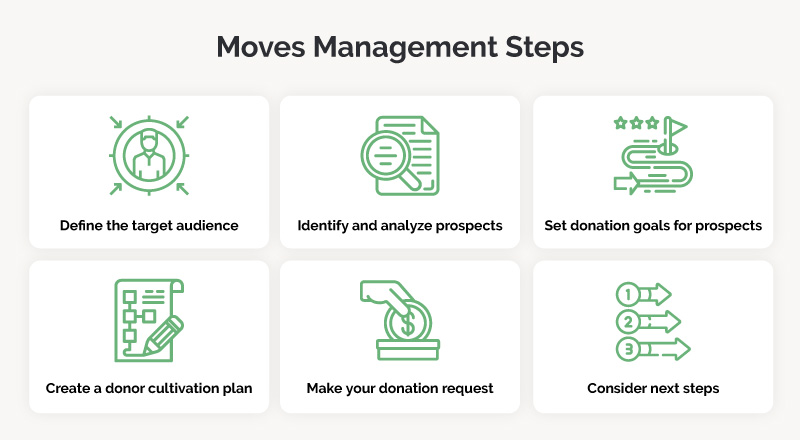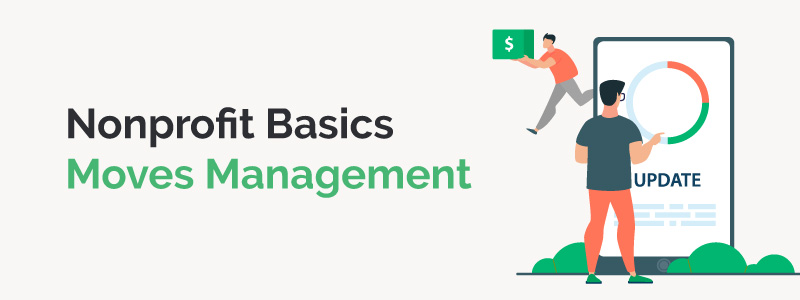Nonprofit Basics: Moves Management
Moving supporters towards donating requires intentionality. To persuade donors to give, especially major donors, your nonprofit will need to regularly interact with them to build a relationship and lead them to giving.
This process, known as moves management, is a precisely defined approach for how a nonprofit interacts with donors and guides them through the donor journey. To begin cultivating and documenting these essential donor relationships, nonprofits should develop an understanding of moves management as a method for organized and deliberate fundraising.
What is moves management?
Moves are efforts a nonprofit makes to earn support by pushing a supporter along in their donation journey. Moves management is the act of tracking and recording those moves to understand where each supporter is in their journey. This intentionality allows nonprofits to take specific and more successful actions based on the status of each supporter.
What is moves management strategy used for?
The moves management strategy you choose to employ in each individual case will depend on the history and status of the supporter. For instance, you should use moves management to advance relationships with these three types of high-value supporters:
- Major donors. Major donors provide the majority of your nonprofit’s funding and are the primary group you will apply moves management strategies to in order to build long-term relationships. Doing so can result in multiple, reliable major gifts over time.
- Capital campaign donors. The bulk of your funding for a capital campaign will come from a select number of major donors who have a strong investment in your nonprofit. Moves management for these donors should include moves where your nonprofit discusses upcoming capital campaign projects, their importance to your mission, and how donors can play a major role in them.
- Planned donors. Planned giving is an option for more than just major donors. As such, nonprofits should also craft a moves management strategy specifically for their moderate donors who may consider planned giving in the future. These moves may not be quite as personalized as you would for major donors, but they should still be deliberate and attuned to each donor’s unique journey.
Moves management is useful for all of these scenarios, as well as for courting gifts for specific events and campaigns. Consider annual events in your moves management strategy, such as ramping up activities near the end of the year when many donors are likely looking to give.

What are the steps in moves management?
Moves management strategies will vary depending on the nonprofit, but for many nonprofits, the general steps are as follows:
- Define the target audience. Ask yourself who your organization needs to reach and why. A good time to do this would be while you’re building your nonprofit’s digital strategy. For instance, for prospective planned donors, you might tailor your digital interactions to include educational materials about planned gifts and donor spotlights for current planned donors.
- Identify and analyze prospects. Comb through your database and find individuals who have sufficient capacity and affinity to make a major gift. Research their past philanthropic history, business connections, and any other data that will be useful for crafting appeals that match their interests.
- Set donation goals for prospects. Create a matching gift chart to organize your efforts. This chart will consist of a set number of donations and how many individuals you can expect will give each amount. Organize prospective donors into the chart by using reasonable approximations based on the person’s history with your organization and wealth indicators.
- Create a donor cultivation plan. During this stage, a nonprofit should outline specific steps and benchmarks for moving each donor to their eventual gift. Have team members track which moves have been made to keep a reliable record, which can be continued for potentially multiple years-long donor relationships.
- Make your donation request. Personalize your asks based on each donor’s cultivation plan. This process as a whole should help you hone in on making the right ask at the right time.
- Consider next steps. Have a plan in place for whether donors respond positively or negatively to your ask. These steps should be to either move them to their next gift or further solidify the relationship and course-correcting before asking again.
Your CRM will likely be your central tool for recording which moves are being made and when. Create donor profiles for each of your prospective donors and implement an internal process to ensure these profiles are updated after each interaction with a donor.
Other Resources to Explore
Nonprofit Basics – Learn more nonprofit management essentials by exploring other expert resources.
Nonprofit Marketing: A Guide for Amplifying Your Mission – Gain a better understanding of nonprofit marketing best practices.
Prospect Research: The Ultimate Guide for Nonprofits – Read more about tools for prospect research and where to begin.


